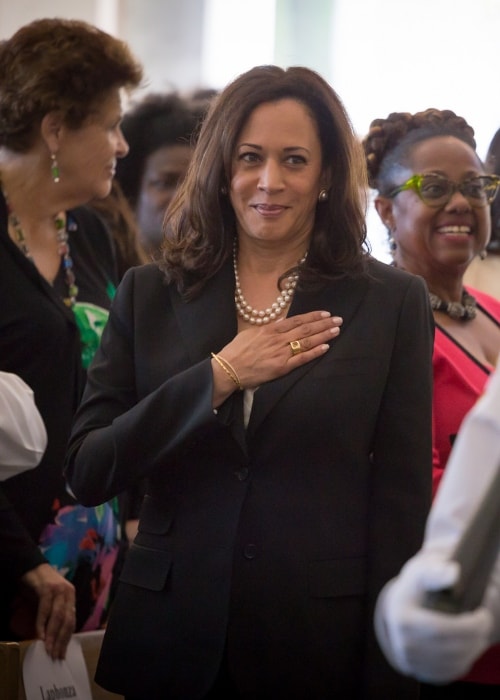Is height truly a factor in political debates? Despite the focus on policies and leadership qualities, physical stature often becomes an unintended point of discussion. A bold statement supporting this question is that Donald Trump's demand ahead of the US presidential debate with Kamala Harris highlights how even minute details can overshadow substantial issues. As we delve into the dynamics between these two towering figures in American politics—literally and figuratively—it’s crucial to examine not just their heights but also the implications such discussions carry.
Ahead of the September 10th debate between Donald Trump and Kamala Harris, Trump issued an unexpected demand regarding podium arrangements. This request underscored the significance he places on visual elements during public appearances. Standing at approximately 6'2 or 6'3, Trump towers over many of his contemporaries, including Kamala Harris, whose official height has been debated. Official records suggest Harris is 5'2, though she clarified in interviews that her actual height is closer to 5'4. With heels, which she frequently wears, her height increases to around 5'7. However, even with this adjustment, there remains a noticeable difference when compared to Trump's imposing figure.
| Bio Data & Personal Information | Career & Professional Information |
|---|---|
| Name: Kamala Devi Harris | Position: Vice President of the United States |
| Date of Birth: October 20, 1964 | Political Party: Democratic |
| Place of Birth: Oakland, California | Elected Offices: Attorney General of California (2011-2017), U.S. Senator from California (2017-2021) |
| Height: 5'4 (Approximately) | Education: Howard University (B.A.), University of California, Hastings College of the Law (J.D.) |
| Official Website | Achievements: First woman, first Black person, and first South Asian American to serve as Vice President |
The issue of height extends beyond mere physical comparison; it reflects broader societal perceptions about authority and presence. Historically, taller candidates have often been perceived as more authoritative, a bias rooted in evolutionary psychology where size equates to strength and protection. Yet, Kamala Harris challenges these stereotypes through her accomplishments and leadership style. As the first woman, first Black person, and first South Asian American vice president, her contributions transcend traditional metrics like height or weight.
Donald Trump, known for his commanding presence both physically and rhetorically, weighs approximately 224 pounds according to recent estimates. His stature aligns with historical precedents favoring taller presidential candidates. For instance, since World War II, most elected presidents have exceeded average male height. Conversely, Kamala Harris represents a shift away from conventional norms. Her journey to becoming vice president underscores the importance of merit over superficial attributes.
Despite discrepancies in reported measurements, Kamala Harris maintains that her true height is slightly above five feet four inches. During interviews, she humorously addressed misconceptions by emphasizing her preference for heels, adding a few extra inches to her overall appearance. Such candor humanizes her image while reinforcing confidence in her abilities irrespective of physical dimensions.
Comparative analyses reveal interesting patterns among past presidents and contenders. For example, Abraham Lincoln stood at six feet four inches, making him one of the tallest leaders in U.S. history. In contrast, James Madison measured just five feet four inches, yet his intellect and vision shaped foundational aspects of American governance. Similarly, contemporary discourse must prioritize substance over form when evaluating political figures.
In addition to height, weight occasionally enters conversations surrounding public figures. While specific numbers vary depending on sources, estimates place Kamala Harris's weight within a healthy range relative to her declared height. These details, however, pale in significance compared to her extensive resume encompassing roles as Attorney General of California, U.S. Senator, and now Vice President.
Carl Harris, another individual sharing the surname but unrelated professionally, provides an interesting juxtaposition. A former running back for the University of Memphis, Carl stands five feet ten inches tall and weighed 195 pounds during his athletic career. His background exemplifies how diverse fields value different traits, further highlighting the need to assess individuals based on relevant criteria rather than universal standards.
Returning to the primary subject, Kamala Harris's impact extends far beyond measurable characteristics. Her tenure as vice president symbolizes progress towards inclusivity and representation in American politics. By challenging preconceived notions tied to gender, race, and ethnicity, she inspires future generations to pursue leadership roles regardless of perceived limitations.
As debates continue shaping narratives leading up to elections, focusing solely on superficial aspects risks undermining critical discussions about policy platforms and governing philosophies. Instead, voters should evaluate candidates holistically, considering their experiences, values, and visions for the nation. Ultimately, what matters most is not how tall someone stands but how effectively they lead.
Therefore, while height comparisons may capture fleeting attention, they represent only a small fraction of each candidate's identity. Both Donald Trump and Kamala Harris possess distinct strengths contributing uniquely to national dialogue. Recognizing this diversity enriches democratic processes, encouraging thoughtful engagement centered on meaningful attributes rather than trivial ones.




